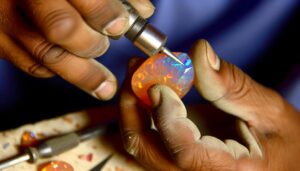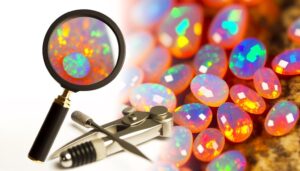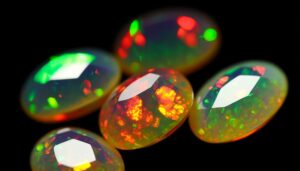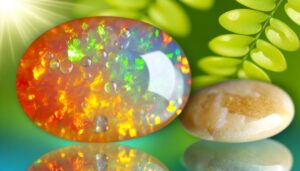How to Develop Forced Fire in Opals: Techniques and Tips
You can force opals to develop fire using several scientific techniques. Heat treatment adjusts molecular alignments, while surface polishing optimizes light interaction.
Controlled rehydration can restore opal color, and sugar-acid treatments can darken the matrix to enhance iridescence. Spectroscopy and electron microscopy provide insights into these transformations.
Ethical considerations are vital, as treatments must be transparently disclosed to maintain market trust and respect cultural heritage. Understanding these factors not only enriches your knowledge of gemology but can also guide you in selecting and caring for your opals.
There's much more to explore about these fascinating processes.
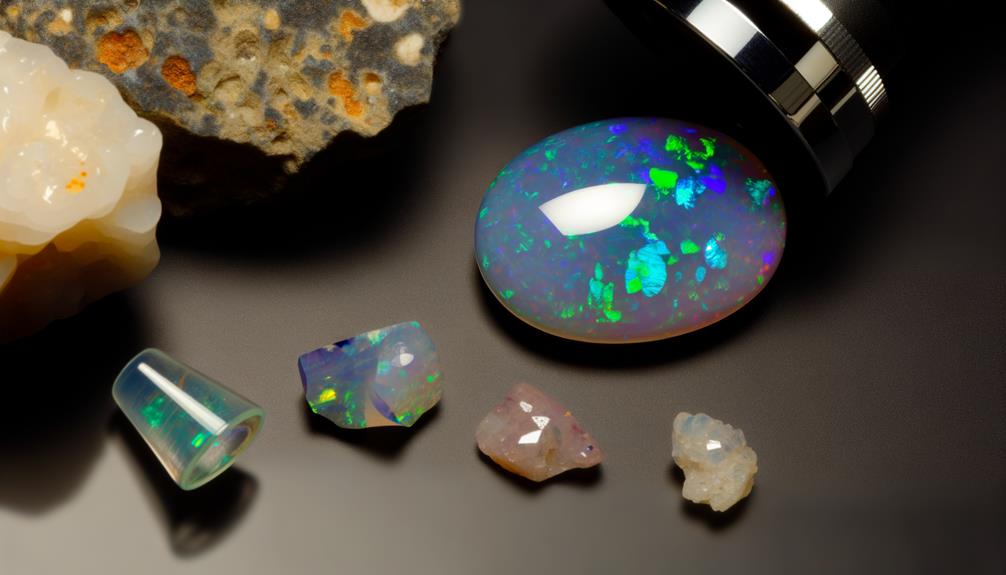
Key Takeaways
- Heat treatment can modify molecular alignment to enhance opal fire.
- Surface polishing maximizes light interaction, enhancing the fire in opals.
- Controlled rehydration can restore and increase the vibrancy of opal colors.
- Sugar-acid treatments create a darker matrix, enhancing the play-of-color effect.
- Advanced methods like spectroscopy and electron microscopy analyze and amplify opal fire.
Natural Formation of Opal Fire
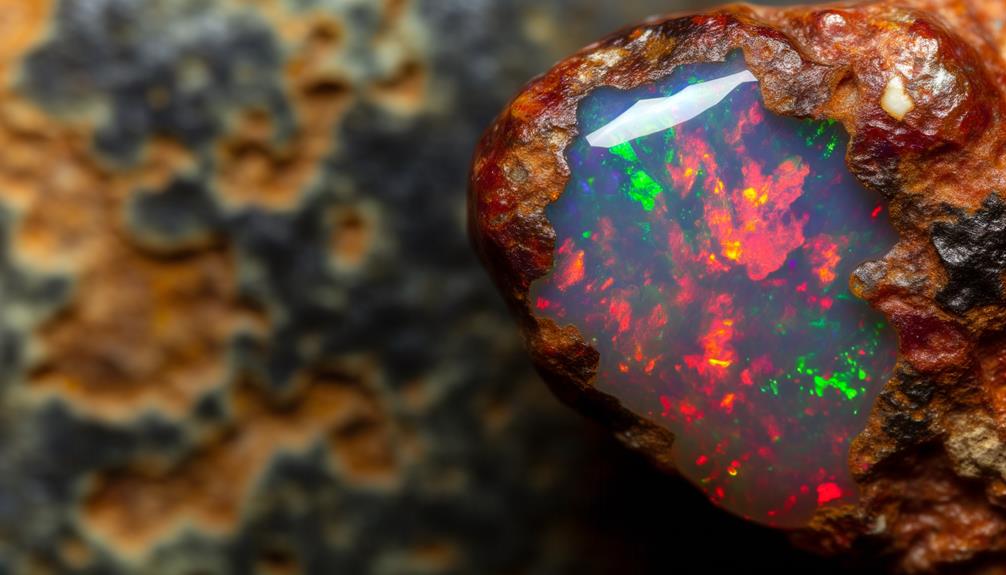
Opal fire naturally forms through the interplay of silica spheres and water over millions of years, creating a diffraction of light that results in a spectrum of vivid colors.
You need to understand that this process begins with the deposition of silica-rich solutions in rock cavities. Over time, water evaporates, leaving behind silica spheres. These spheres self-organize into a tightly packed, regular structure.
When light enters this structure, it diffracts, producing the iridescence known as 'fire.' The size and arrangement of these spheres are essential; they determine the specific wavelengths of light that are diffracted.
This natural, painstaking process is why opal fire showcases such a broad range of colors, from deep reds to vibrant blues.
Factors Influencing Opal Colors
Understanding the natural formation of opal fire leads to recognizing the pivotal factors that influence the array of colors you see in these gemstones.
The primary factor is the size and arrangement of silica spheres within the opal. When these spheres are uniformly packed, they diffract light at different wavelengths, creating vibrant colors. Smaller spheres generally produce blue and violet hues, while larger spheres yield reds and oranges.
Additionally, the water content within the opal affects its translucency and brightness. Environmental conditions like temperature and pressure during the opal's formation also play significant roles.
Techniques for Enhancing Opal Fire
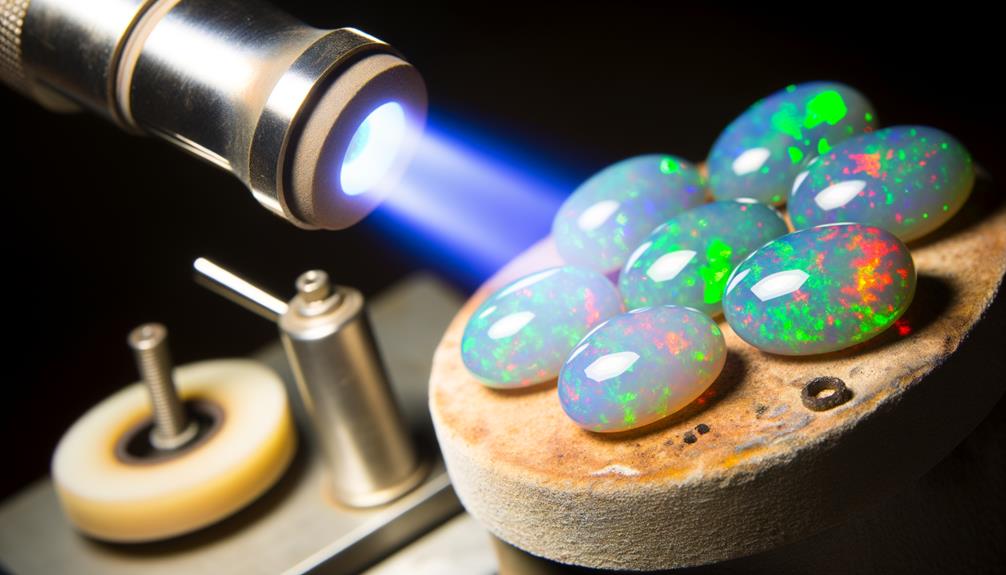
To enhance an opal's fire, jewelers and gemologists often employ techniques like heat treatment, surface polishing, and controlled rehydration. Heat treatment can intensify an opal's iridescence by altering its internal structure.
Surface polishing removes imperfections, allowing light to interact more effectively with the silica spheres.
Controlled rehydration, where an opal is gradually reintroduced to moisture, can restore its vibrant colors.
Here are some key techniques:
- Heat Treatment: Enhances iridescence by modifying molecular alignment.
- Surface Polishing: Maximizes light reflection and refraction.
- Controlled Rehydration: Restores opal's natural luster by adjusting water content.
- Sugar-Acid Treatment: Creates a darker matrix, making fire more pronounced.
Understanding these methods allows you to appreciate the intricate processes involved in enhancing opals.
Scientific Methods and Experiments
Researchers employ advanced scientific methods and controlled experiments to explore new ways of enhancing an opal's fire. You can feel the thrill of discovery as they utilize spectroscopy, electron microscopy, and thermal treatments. By analyzing the structural changes in opals, they aim to amplify the play-of-color effect. Imagine the excitement when a dull stone transforms into a vibrant gem.
| Experimental Technique | Purpose | Emotional Impact |
|---|---|---|
| Spectroscopy | Analyzing light interaction | Awe at revealing colors |
| Electron Microscopy | Observing structural details | Fascination with detail |
| Thermal Treatments | Enhancing color play | Anticipation of results |
Their precise methods reflect a deep understanding of gemology, aiming to reveal the ultimate potential of these enchanting gems.
Ethical Considerations in Gemology
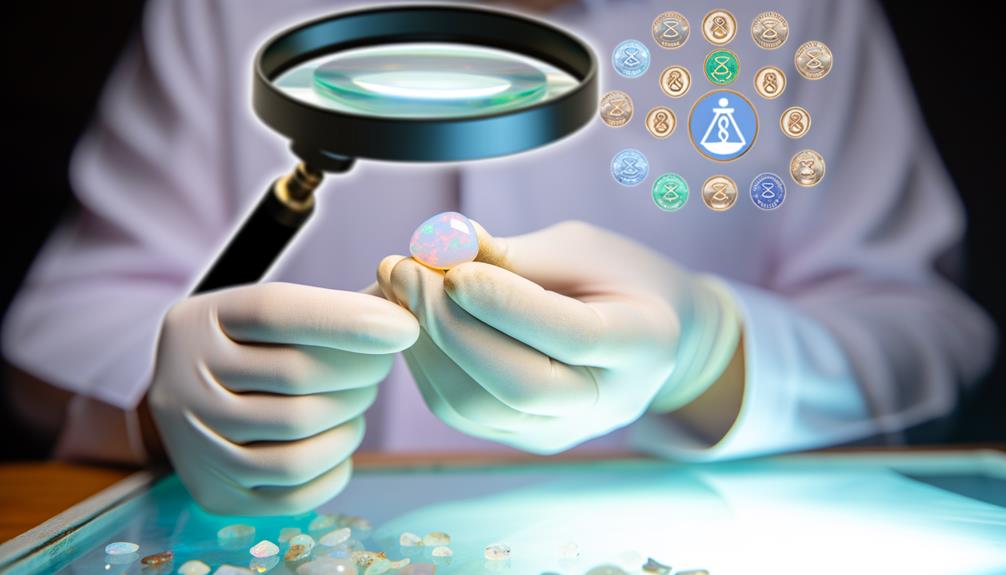
Exploring the ethical terrain of gemology requires a delicate balance between scientific innovation and the preservation of natural beauty. When you consider the manipulation of opals to enhance their fire, you must weigh potential benefits against ethical concerns. Modifying these gems can lead to misrepresentation and undermine the integrity of natural specimens. You also risk devaluing naturally occurring opals by flooding the market with altered stones.
To guide your ethical considerations, reflect on the following:
- Authenticity: Maintain transparency about whether an opal has been treated.
- Value: Take into account how treatments affect market worth and collector trust.
- Environmental Impact: Assess the ecological costs of treatment processes.
- Cultural Significance: Honor the cultural heritage linked to natural gemstones.
This approach guarantees ethical gemology practices.
Conclusion
To wrap up, while you can't compel opals to develop fire, you can enhance their natural brilliance through specific techniques.
For example, 80% of the world's precious opals come from Australia, where controlled conditions can amplify their vibrant colors.
Utilizing scientific methods like hydrophane treatment, you can notably enhance an opal's fire.
However, ethical considerations in gemology caution against misleading practices, ensuring transparency and authenticity in the gemstone market.

